Gold Shines as Trade Tensions Rise

Tariff-Driven Gold Surge
On July 14, 2025, global markets pivot back toward risk aversion as U.S. President Donald Trump renews tariff threats, targeting both the European Union and Canada. Gold (XAU/USD) climbs above $3,350, recovering its shine amid rising geopolitical uncertainty. The U.S. Dollar shows mixed reactions — EUR/USD pushes toward 1.1700 while NZD/USD drops near 0.6000 on tariff spillovers and looming Chinese trade data. GBP/USD remains vulnerable around 1.3500 amid Brexit silence and USD strength. USD/CAD extends higher toward 1.3700, pressured by direct trade rhetoric from Washington. Traders now shift focus to U.S. retail sales and China’s external sector updates.
Gold Price Forecast (XAU/USD)
Current Price and Context
Gold (XAU/USD) trades above $3,350, gaining momentum as renewed trade tensions revive safe-haven flows. Traders rushed to hedge geopolitical risk after U.S. President Trump reignited tariff threats on both Europe and Canada. The yellow metal recovered from recent lows, reflecting market caution despite firm U.S. data.
Key Drivers
Geopolitical Risks: Trump’s tariff threats against the EU and Canada trigger global risk aversion, boosting gold’s appeal.
US Economic Data: Mixed signals from jobless claims and inflation data contribute to USD uncertainty, favoring gold.
FOMC Outcome: The Fed’s cautious stance supports yield-sensitive assets like gold as rate cuts remain on the table.
Trade Policy: Renewed tariff rhetoric shifts capital into safe havens like gold and U.S. Treasuries.
Monetary Policy: Divergent global central bank outlooks continue to support non-yielding gold in risk-off settings.
Technical Outlook
Trend: Short-term bullish recovery above $3,350.
Resistance: $3,370, followed by $3,400 and $3,434.
Support: $3,332, then $3,300 and $3,275.
Forecast: Gold could extend toward $3,370–$3,400 if geopolitical uncertainty persists; a pullback below $3,332 would signal consolidation.
Sentiment and Catalysts
Market Sentiment: Bullish bias fueled by tariff headlines and demand for hedges.
Catalysts: U.S. retail sales, Fed speakers, and fresh trade headlines involving the EU and Canada.
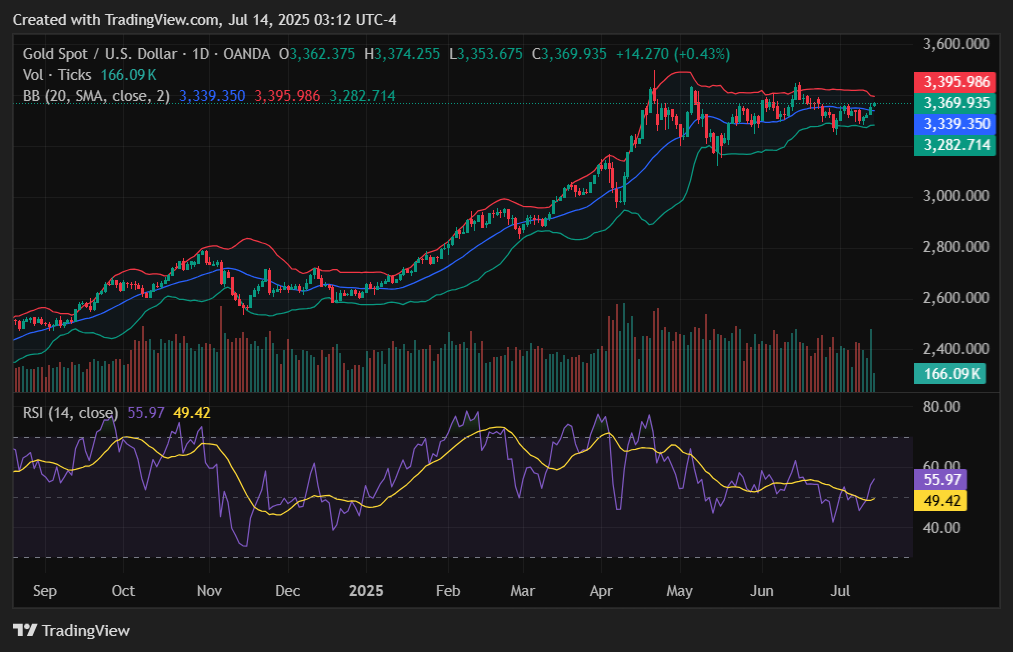
GBP/USD Forecast
Current Price and Context
GBP/USD hovers around 1.3500, struggling to recover as the British Pound remains pressured by a resilient U.S. Dollar and lack of fresh UK drivers. Despite holding ground near recent lows, the pair appears vulnerable to renewed selling, particularly as global risk sentiment remains fragile amid tariff-related concerns.
Key Drivers
Geopolitical Risks: Global trade tensions weigh on broader risk appetite, indirectly affecting GBP via USD strength.
US Economic Data: Solid U.S. data, including inflation and labor market resilience, continues to support the greenback.
UK Economic Outlook: With limited domestic catalysts and Brexit-related silence, the Pound lacks the fuel for a breakout.
Trade Policy: U.S. tariff rhetoric boosts USD demand, keeping pressure on GBP/USD despite mild equity stability.
Monetary Policy: Bank of England’s cautious stance offers little support, while Fed’s hawkish tilt keeps GBP on the defensive.
Technical Outlook
Trend: Bearish to neutral; consolidation after steep drop.
Resistance: 1.3530, then 1.3600 and 1.3665.
Support: 1.3460, followed by 1.3420 and 1.3350.
Forecast: GBP/USD may remain rangebound unless a shift in global sentiment or strong UK data sparks momentum.
Sentiment and Catalysts
Market Sentiment: Cautiously bearish as risk flows favor the USD.
Catalysts: U.K. GDP updates, U.S. retail sales, and tariff-related headlines involving the EU.
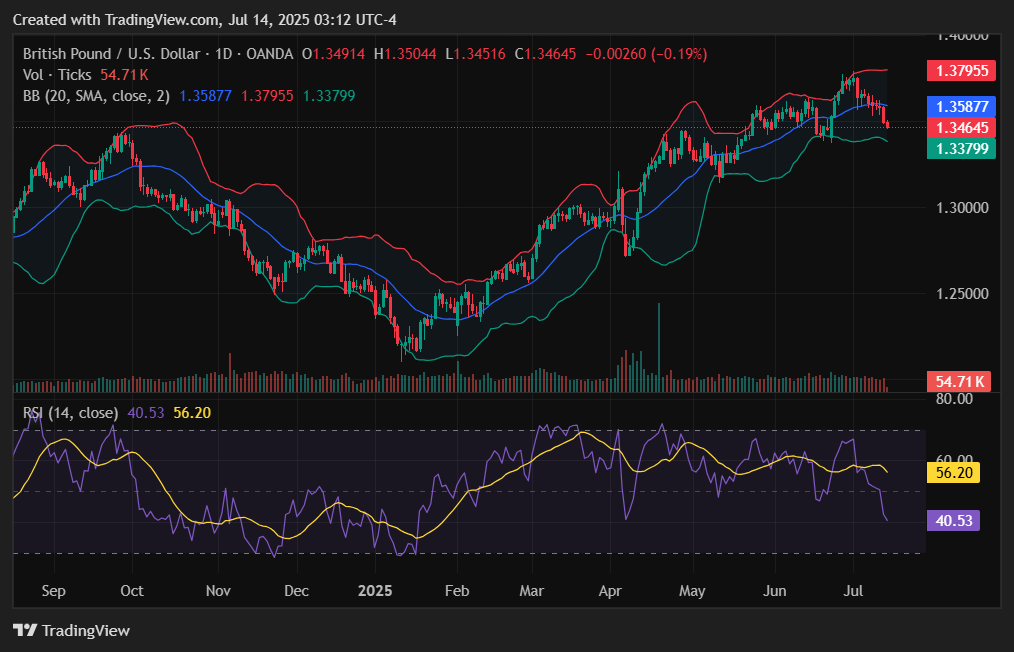
NZD/USD Forecast
Current Price and Context
NZD/USD softens near the 0.6000 level, under pressure from resurging trade war fears and cautious sentiment ahead of China’s trade balance data. The Kiwi’s earlier gains faded as traders weighed the implications of global tariffs on Asia-Pacific exports, particularly given New Zealand’s strong trade links with China.
Key Drivers
Geopolitical Risks: U.S. tariff threats intensify global uncertainty, indirectly impacting export-driven economies like New Zealand.
US Economic Data: Broad USD strength from robust U.S. metrics drags NZD lower, especially as traders brace for inflation data.
China’s Trade Balance: Markets await June’s Chinese trade report, a key gauge for NZD given New Zealand’s deep economic ties with Beijing.
Trade Policy: Worsening trade rhetoric continues to spook markets, reducing risk appetite and hurting high-beta currencies.
Monetary Policy: RBNZ’s neutral tone provides little defense as U.S. interest rate divergence remains in focus.
Technical Outlook
Trend: Bearish short-term bias; momentum weakening near key support.
Resistance: 0.6055, then 0.6100 and 0.6160.
Support: 0.5980, then 0.5950 and 0.5900.
Forecast: A daily close below 0.5980 could signal further downside, especially if Chinese trade data disappoints.
Sentiment and Catalysts
Market Sentiment: Bearish; tariff tensions weigh heavily on commodity and trade-linked currencies.
Catalysts: Chinese trade data, U.S. CPI release, and any easing or escalation of Trump’s tariff threats.
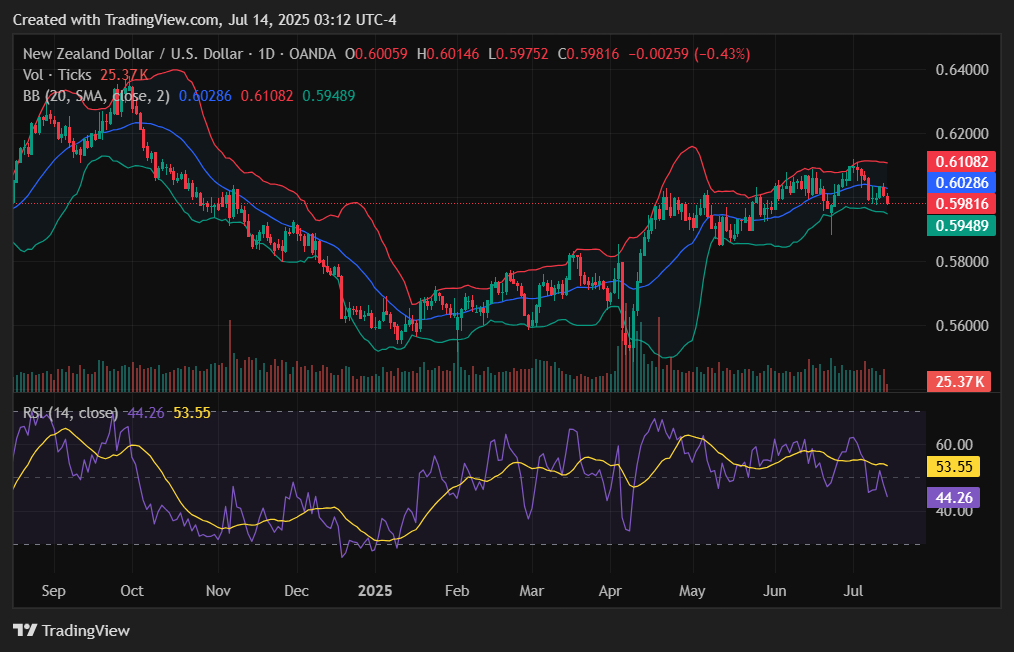
EUR/USD Forecast
Current Price and Context
EUR/USD trades near 1.1700, recovering modestly as the U.S. Dollar retreats slightly in response to renewed tariff tensions with the European Union. The Euro benefits from short-term USD softness but remains capped by ongoing uncertainty surrounding the impact of proposed trade policies.
Key Drivers
Geopolitical Risks: Trump’s fresh tariff threats targeting the EU stoke market volatility, initially pressuring the Euro before USD weakness takes hold.
US Economic Data: Mixed U.S. data keeps the Dollar volatile, offering EUR/USD a short-term lift amid shifting Fed expectations.
Eurozone Outlook: The bloc’s recent stability contrasts with U.S. trade friction, helping the Euro find temporary footing.
Trade Policy: The threat of escalating U.S.-EU tariffs could become a medium-term headwind if negotiations falter.
Monetary Policy: ECB’s cautious stance remains a weight, though less so than the uncertainty surrounding Fed rate path.
Technical Outlook
Trend: Cautious rebound within short-term range.
Resistance: 1.1730, then 1.1765 and 1.1800.
Support: 1.1670, followed by 1.1625 and 1.1600.
Forecast: EUR/USD may attempt a move toward 1.1730–1.1765 if USD softness persists; failure to hold 1.1670 may invite selling.
Sentiment and Catalysts
Market Sentiment: Mixed; cautious optimism around Eurozone resilience, tempered by tariff concerns.
Catalysts: U.S.-EU trade negotiations, U.S. inflation figures, and Eurozone ZEW economic sentiment.
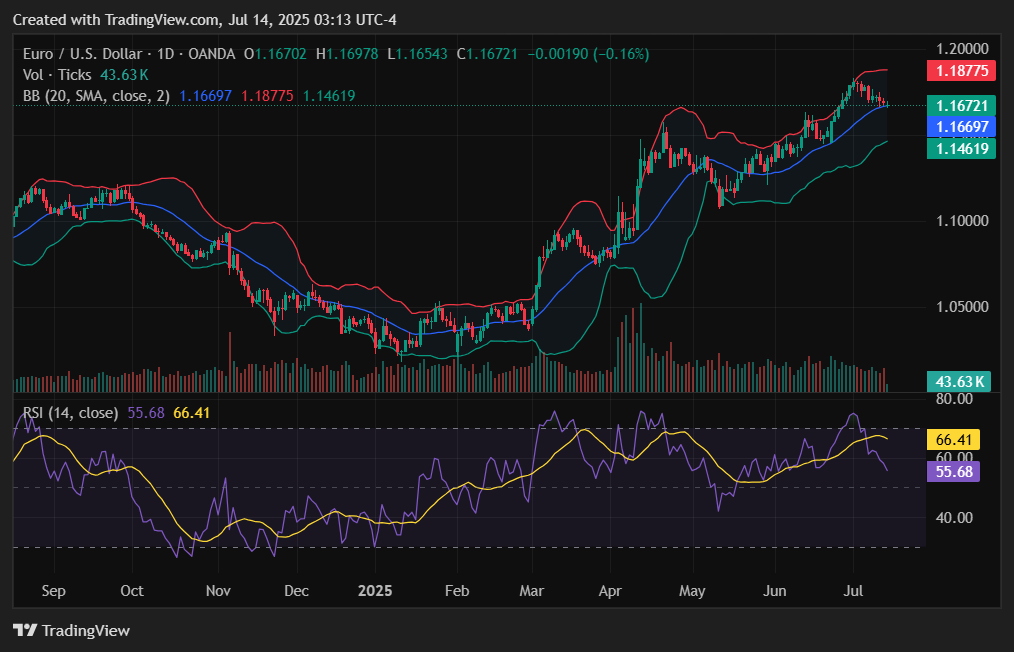
USD/CAD Forecast
Current Price and Context
USD/CAD holds firm near 1.3700, supported by renewed U.S. tariff threats targeting Canada. The pair sustains bullish momentum as risk sentiment falters and oil prices struggle to lift the Loonie. With trade tensions rising and WTI crude under pressure, USD/CAD remains elevated heading into the week’s key data releases.
Key Drivers
Geopolitical Risks: Trump’s 35% tariff announcement on Canadian imports adds direct pressure to the Canadian Dollar, widening the trade gap.
US Economic Data: Strong U.S. metrics continue to support the greenback, enhancing USD/CAD upside potential.
Canadian Outlook: Weaker oil and trade pressure from the U.S. increase downside risks for CAD, despite otherwise steady domestic fundamentals.
Trade Policy: Tariff tensions are front and center, driving the pair higher with markets bracing for retaliation or renegotiation.
Monetary Policy: BoC remains cautious, while the Fed holds a hawkish tone—yield spreads continue to favor the USD.
Technical Outlook
Trend:Bullish continuation, nearing breakout levels.
Resistance: 1.3725, then 1.3750 and 1.3790.
Support: 1.3675, followed by 1.3620 and 1.3580.
Forecast: A sustained break above 1.3725 could signal extension toward 1.3750–1.3790; reversal risks grow only below 1.3620.
Sentiment and Catalysts
Market Sentiment: Bullish for USD/CAD amid heightened trade tensions and softening crude oil.
Catalysts: U.S. Retail Sales, Canada CPI, crude oil trends, and official responses to Trump’s tariff measures.
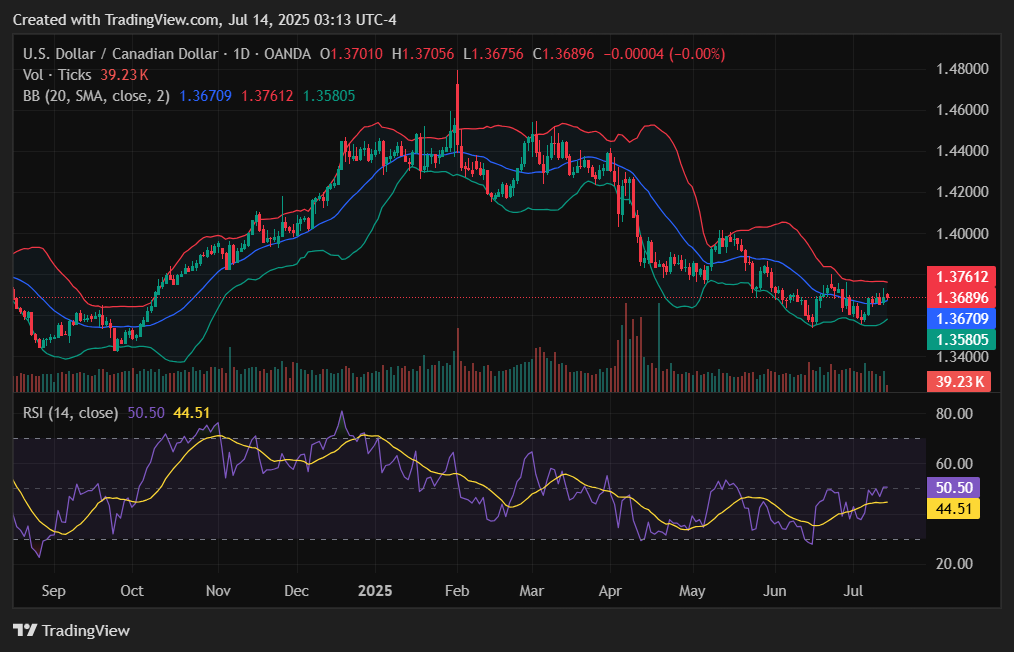
Wrap-up
Markets entered the week on edge, with gold leading the safe-haven charge past $3,350 as global trade tensions intensified. The U.S. Dollar stayed firm overall, with EUR/USD and USD/CAD reflecting tariff-sensitive flows. GBP/USD and NZD/USD remain weighed by domestic and external pressures. Traders now await major data prints — including U.S. retail sales and Chinese trade figures — alongside any escalation or resolution in Trump’s tariff campaign. Volatility remains elevated as policy and politics dominate sentiment.
Ready to trade global markets with confidence? Join Moneta Markets today and unlock 1000+ instruments, ultra-fast execution, ECN spreads from 0.0 pips, and more! Start now with Moneta Markets!





















